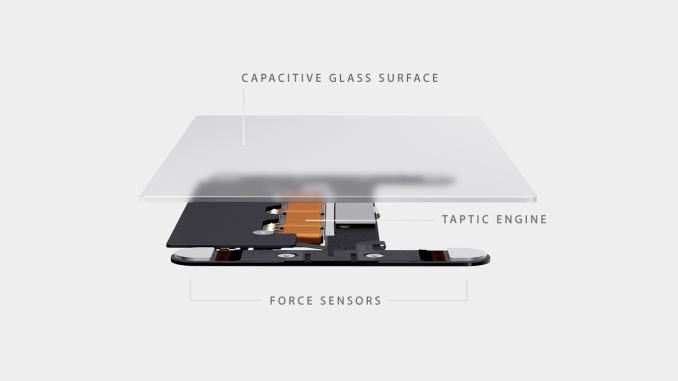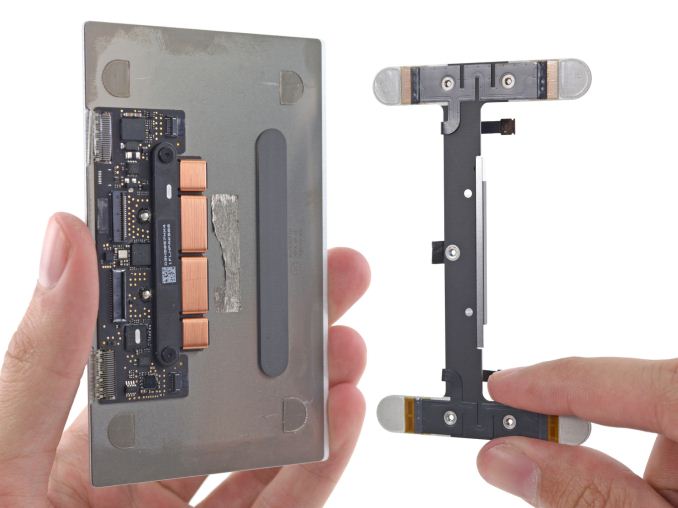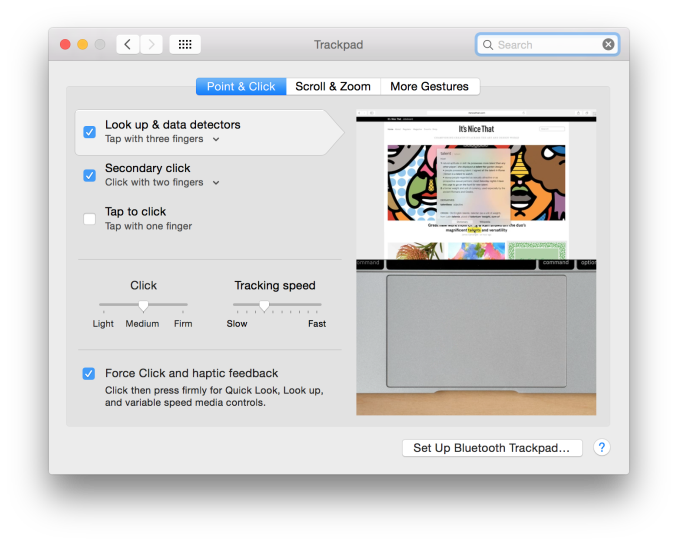The 2015 MacBook Review
by Ryan Smith on April 14, 2015 10:15 AM ESTForce Touch Trackpad
Along with Apple’s changes to their keyboard, the company has also gone in and significantly reworked their trackpad. The new Force Touch Trackpad represents the biggest change to Apple’s trackpad design since the creation of the capacitive, multi-touch pivoting trackpad introduced on the unibody MacBook Pro. In putting together the Force Touch Trackpad, Apple has significantly reworked the internals of the trackpad, creating a trackpad that behaves a lot like their traditional trackpad with some new features, but under the hood relies on some very different mechanisms.
The big change here is that Apple has done away with the traditional pivot and switch mechanism. With pivot and switch, the capacitive trackpad surface would act like a small touchscreen, and underneath it was a switch to register when the trackpad was pressed down. Mechanically the trackpad pivoted from the top (Apple likes to compare it to a diving board), with the trackpad inferring what action to take based on the combination of the capacitive readings and the switch reading. Multi-finger gestures would rely solely on the capacitive layer, primary/secondary clicks would be based on the number of fingers in use when the switch was actuated, etc.
The Force Touch Trackpad on the other hand eliminates the pivot and switch mechanism in favor of a combination of an electromagnet and force/pressure sensors. The pressure sensors essentially replace the physical switch, allowing the trackpad to tell when it has been pressed based on the amount of pressure, and thanks to the pressure sensors it can now tell how hard it has been pressed as opposed to the binary nature of the physical switch. Meanwhile without a physical switch in place to provide the clicking sensation and feedback of pressing down on the touchpad, Apple’s electromagnet – the Taptic Engine – activates to simulate the feeling and noise of pressing a switch.
Update 04/15/2015: iFixit has a great shot of the trackpad's internals, including a good look at just how big the electromagnet/taptic engine really is.
The end result is that the MacBook’s trackpad is among the first wave of devices that ships with Apple’s next generation trackpad and the enhanced capabilities that go with it. Ignoring the pressure sensitivity for a moment (we’ll get back to it), replacing the pivot and switch for an electromagnet works shockingly well. From a touch & feel standpoint the Force Touch Trackpad feels virtually identical to a traditional trackpad, to the point where it’s more than a bit uncanny. In practice you are not actually triggering a switch nor is the trackpad really moving (technically it’s deforming ever so slightly), but it sure feels like you’re working a switch. Apple has clearly done their homework on getting an electromagnet to emulate a switch, to great results. Meanwhile they don’t have the trackpad’s acoustics precisely matching a switch, but the resulting pinball-machine like plunk is close enough to a click that I don’t imagine anyone will mind the difference.
One side benefit of this change is that the trackpad feels the same throughout, and unlike the pivoting trackpad does not require more or less force depending on where you are relative to the pivot point. The variable force required has never been a major problem in my experience, but it is nice to no longer need to worry about where your fingers are relative to the top, and consequently how much force you need to use.
However the bigger deal is that by making the amount of force required to click consistent throughout the entire trackpad, Apple can now use the amount of pressure applied as another input, making the trackpad pressure-sensitive. The underlying pressure sensors and electromagnet are by default programmed to have two levels of feedback – a shallower press is equivalent to a click – and a deeper press brings about the pressure-sensitive “Force Click.” What force clicking does depends on the application, and right now it’s clear that Apple is still experimenting with what they can do with pressure sensitivity. The most obvious uses include line thickness in drawing applications, but the company is also using it for things such as variable speed fast forward and rewinding in QuickTime/iMovie. At times the force click is treated like a 3rd (tertiary) click, and other times the result is based on variable pressure. Since this is a new (and uncommon) feature there’s no global action assigned to the force click – nor does it behave as a middle click on a regular mouse – so what happens is up to the application.
In implementing force click and the Force Touch Trackpad, Apple does offer the ability to control the amount of pressure required and whether force click is active. With force click deactivated the trackpad behaves more or less identical to a traditional trackpad with a single click level. Meanwhile the click pressure setting is interesting, though I’m not entirely convinced it’s all that effective. Short of the tools to actually measure click pressure, I’m not so sure Apple is changing the amount of pressure required to trigger a click so much as they’re changing how hard the electromagnet vibrates. The feedback change is certainly very subtle going from light to firm, and if there is a change in the amount of pressure required then it is certainly equally subtle.
Ultimately whether the Force Touch Trackpad is a major upgrade or not is going to depend on a user’s ability to make use of the force click features. Even turned off, the new trackpad is essentially an improved version of the old trackpad without the minor drawbacks of the pivot mechanism. But with the force click turned on, then it brings new (though not always useful) actions to the trackpad that in turn makes it a bigger upgrade over the old trackpad.
In any case, the MacBook along with the 2015 MacBook Pro 13” are the first wave of devices to implement the new Force Touch Trackpad. Given its expanded capabilities I would expect Apple to eventually replace many (if not all) of their trackpads with this new design. Certainly the 15” MacBook Pro is a likely candidate, as is a future version of the Magic Trackpad. What remains to be seen is whether the next MacBook Air also gets this new trackpad, or if Apple withholds it to keep the products differentiated and to keep the costs of the MacBook Air down.














354 Comments
View All Comments
osxandwindows - Saturday, October 17, 2015 - link
The trackpad is good enoughws3 - Tuesday, April 14, 2015 - link
Right click is a two finger click. Force click is something else.Impulses - Tuesday, April 14, 2015 - link
Meh, it's not really a hybrid device IMO, it's just the logical evolution of the Air from Apple's PoV (whether we agree with it or not). I think it'll be interesting to see just what corners they cut or how slowly they develop future Airs if that is to be the be budget model, I guess TN is there to stay which is luscious at $1K.I don't see the point of a touchscreen unless you have a 180 degree hinge or some actual split/hybrid mode, reaching over keyboard to touch the screen constantly is all kinds of awkward. Yoga/Surface/Transformer are hybrids.
darwinosx - Tuesday, April 14, 2015 - link
You didn't really read about force click then and the trackpad is a far better solution that a touchscreen.Try using one.
kyuu - Tuesday, April 14, 2015 - link
Trackpads suck even when they are good.akdj - Thursday, April 16, 2015 - link
You've obviously NEVER used a MacBook, MacBook Pro, or an Air. I remember thinking like you almost a decade ago. Found my Mac, haven't looked back (nor carried a mouse). NOTHING is worse than a touchscreen when attempting to use OS X or Windows (I've got an 8.1 13" HP 2in 1 and you're correct, PC touch pads suck, but greasy screens and impossible touch targeting on today's OSes doesn't work. At. AllAlexey291 - Thursday, April 30, 2015 - link
I've used an mba for a while. Trackpad is a pain in the ass. Its certainly better than on a lot of windows laptops but its still a piece of shite.Xajel - Tuesday, April 14, 2015 - link
I want MacBook Pro with Skylake CPU and USB Type-C + USB Type-A in one side, and same for the other side, and no magsafe charging, ( not to mention the regular miniDP + Thunderbolt + SD card reader ) so we can use any of Type-C ports to charge the laptopFlunk - Tuesday, April 14, 2015 - link
I honestly think this would be a lot more usable if they had dropped the headphone jack and instead had 2 USB type-c connectors. No being able to plug in anything at all while charging makes this product totally unusable, at least for me.ws3 - Tuesday, April 14, 2015 - link
Why is it impossible for you to unplug the charging cable while you plug something else in? And why are you so certain that you will need to charge all the time anyway?